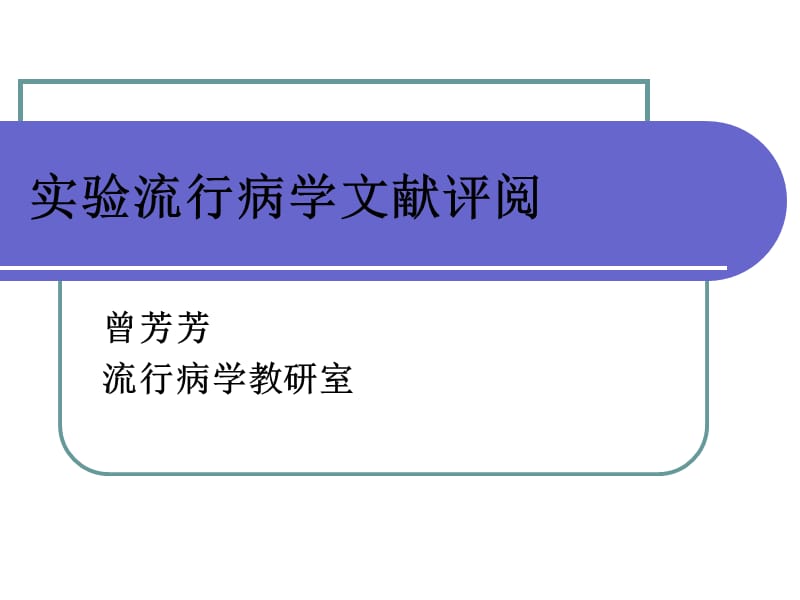 实验流行病学文献评阅.ppt
实验流行病学文献评阅.ppt



《实验流行病学文献评阅.ppt》由会员分享,可在线阅读,更多相关《实验流行病学文献评阅.ppt(32页珍藏版)》请在装配图网上搜索。
1、实验流行病学文献评阅,曾芳芳 流行病学教研室,A. Description of the evidence 证据的描述,What was the study design and how to collect data we need? What was the study population? What was the exposure? What was the outcome? What was the main result?,B. Internal validity consideration of non-causal explanations 内部真实性考虑是否有非因果解释,A
2、re the results likely to be affected by selection bias? 是否由于选择偏移所致 Are the results likely to be affected by observation bias? 是否由于观察偏移所致 Are the results likely to be affected by confounding? 是否由混杂偏移所致 Are the results likely to be affected by chance variation? 是否出于偶然因素,C. Internal validity considerat
3、ion of positive features of causation内部真实性因果关系阳性特征的考虑,1. Is there a correct time relationship? 是否存在前因后果的时间关系 2. Is the relationship strong? 联系强度 3. Is there a dose-response relationship? 是否存在剂量反应关系? Are the results consistent within the study? 不同的相关研究指标结果是否一致 5. Is there any specificity within the s
4、tudy? 研究是否存在特异性?,D. External validitygeneralization of the results外部特异性结果能否外推,Can the study results be applied to the eligible population? 结果能否适用于合格研究人群 Can the study results be applied to the source population? 结果能否适用于源人群 Can the study results be applied to other relevant populations? 结果是否适用于其他相关人群
5、,E. Comparison of the results with other evidence 与其它证据的比较,1. Are the results consist with other evidence, particularly evidence from studies of similar or more powerful study design? 研究结果是否与其它研究(尤其是设计更好,证据更强的)结果相似或一致? 2. Does the total evidence suggest any specificity? 研究结果是否存在特异性? 3. Are the resul
6、ts plausible, in terms of a biological mechanism? 研究结果是否合理,能否用生物学机制解释 4. If a major effect is shown, is it coherent with the distribution of the exposure and the outcome? 如果存在联系,该联系与人群的暴露与结局分布是否一致?,The Revised CONSORT Statement for Reporting Randomized Trials:Explanation and Elaboration,Ann Intern M
7、ed. 2001 Apr 17;134(8):663-94.,INCOMPLETE AND INACCURATE EPORTING,information on whether assessment of outcomes* was blinded was reported in only 30% of 67 trial reports in four leading journals in 1979 and 1980 only 27% of 45 reports published in 1985 defined a primary end point* (14), and only 43%
8、 of 37 trials with negative findings published in 1990 reported a sample size* calculation,Of 119 reports stating that all participants* were included in the analysis in the groups to which they were originally assigned (intention-to-treat* analysis), 15 (13%) excluded patients or did not analyze al
9、l patients as allocated,Checklist of Items To Include When Reporting a Randomized Trial,Title and Abstract,How participants were allocated to interventions (e.g., “random allocation,” “randomized,” or “randomly assigned”).,Introduction,Scientific background and explanation of rationale,Methods-Parti
10、cipants,Eligibility criteria for participants The settings and locations where the data were collected,Methods- Interventions,Precise details of the interventions intended for each group and how and when they were actually administered.,Methods- Objectives,Specific objectives and hypotheses.,Methods
11、- Outcomes,Clearly defined primary and secondary outcome measures. When applicable, any methods used to enhance the quality of measurements (e.g., multiple observations, training of assessors).,Methods- Sample size,How sample size was determined When applicable, explanation of any interim analyses a
12、nd stopping rules.,Methods- Randomization,Method used to generate the random allocation sequence Details of any restriction of randomization (e.g., blocking, stratification) Method used to implement the random allocation sequence (e.g., numbered containers or central telephone), clarifying whether t
13、he sequence was concealed until interventions were assigned.,Who generated the allocation sequence, who enrolled participants, and who ssigned participants to their groups.,Methods- Blinding (masking),Whether or not participants, those administering the interventions, and those assessing the outcome
14、s were blinded to group assignment. If done, how the success of blinding was evaluated.,Methods- Statistical methods,Statistical methods used to compare groups for primary outcome(s). Methods for additional analyses, such as subgroup analyses and adjusted analyses.,Results-Participant flow,Flow of p
15、articipants through each stage (a diagram is strongly recommended). Specifically, for each group report the numbers of participants randomly assigned, receiving intended treatment, completing the study protocol, and analyzed for the primary outcome. Describe protocol deviations from study as planned
16、, together with reasons.,Results-Recruitment,Dates defining the periods of recruitment and follow-up.,Results-Baseline data,Baseline demographic and clinical characteristics of each group,Results-Numbers analyzed,Number of participants (denominator) in each group included in each analysis and whethe
17、r the analysis was by “intention to treat.” State the results in absolute numbers when feasible (e.g., 10 of 20, not 50%).,Results-Outcomes and estimation,For each primary and secondary outcome, a summary of results for each group and the estimated effect size and its precision (e.g., 95% confidence
18、 interval).,Results-Ancillary analyses,Address multiplicity by reporting any other analyses performed, including subgroup analyses and adjusted analyses, indicating those prespecified and those exploratory.,Results- Adverse events,All important adverse events or side effects in each intervention gro
19、up.,Discussion-Interpretation,Interpretation of the results, taking into account study hypotheses, sources of potential bias or imprecision, and the dangers associated with multiplicity of analyses and outcomes.,Discussion-Generalizability,Generalizability (external validity) of the trial findings.,Discussion-Overall evidence,General interpretation of the results in the context of current evidence.,谢 谢!,
- 温馨提示:
1: 本站所有资源如无特殊说明,都需要本地电脑安装OFFICE2007和PDF阅读器。图纸软件为CAD,CAXA,PROE,UG,SolidWorks等.压缩文件请下载最新的WinRAR软件解压。
2: 本站的文档不包含任何第三方提供的附件图纸等,如果需要附件,请联系上传者。文件的所有权益归上传用户所有。
3.本站RAR压缩包中若带图纸,网页内容里面会有图纸预览,若没有图纸预览就没有图纸。
4. 未经权益所有人同意不得将文件中的内容挪作商业或盈利用途。
5. 装配图网仅提供信息存储空间,仅对用户上传内容的表现方式做保护处理,对用户上传分享的文档内容本身不做任何修改或编辑,并不能对任何下载内容负责。
6. 下载文件中如有侵权或不适当内容,请与我们联系,我们立即纠正。
7. 本站不保证下载资源的准确性、安全性和完整性, 同时也不承担用户因使用这些下载资源对自己和他人造成任何形式的伤害或损失。
